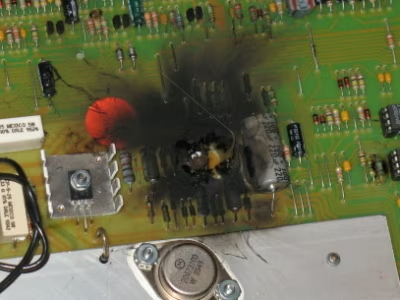- Knowing the Voc of your solar panel is critical to avoid damaging your equipment
- WattBuild's Solar Panel Finder can do the Voc checking for you with many inverters, power stations, and charge contollers on the market.

Damage my equipment? How do I make sure THAT doesn't happen?
Well, you will need to know four things.- The Voc of your solar panel at STC
- The voltage limit of the hardware that hooks up to your solar panels (inverter, power station, or charge controller)
- The way multiple solar panels are wired together before being hooked up to your other hardware
- The coldest temperature you expect your location to ever experience
How do I find out the Voc of a panel?
All solar panels have a "Voc at STC" rating specified by the manufacturer. It's usually a figure between 10-70 Volts, but each panel will have an official spec.If you already own a panel
It is usually in one of three places:- On the back of the panel, on a sticker with the Voc and other information
- In the manual that came with the panel
- Online, on a datasheet PDF from the retailer or manufacturer
If you don't own the panel yet
If you are still shopping, retailers and manufacturer often provide the Voc on their site. Here on WattBuild, tools like our Solar Panel Finder know the Voc of many panels so you don't have to do the research.So now I know the official Voc and can use that number?
Well, there's one complication. The Voc number that manufacturers provide is for "Standard Test Conditions" (STC). The temperature for STC is 25 degrees Celsius (77 degrees Fahrenheit). The actual Voc of your solar panel at any given moment is dependent on the ambient temperature. When temperature increases, Voc goes down, and it goes up as it gets colder. So, to really check how safe your solar panels are for your equipment, you need to factor in temperature.OK, so how do I factor in temperature?
Panel manufacturers also publish a spec for how much their Voc changes with temperature. This is called the "Temperature Coefficient of Voc", also called "Beta Voc". It's usually a negative number, and it's usually between -0.2% and -0.5%. This means that for every degree Celsius the temperature increases, Voc will decrease by that percentage. So, if the temperature coefficient of your panel is -0.4%, and the temperature increases by 10 degrees Celsius, the Voc will decrease by 4%. If the Voc was 50V at STC, it will be 48V at 10 degrees Celsius above STC. If the temperature decreases by 10 degrees Celsius, the Voc will increase by 4%. If the Voc was 50V at STC, it will be 52V at 10 degrees Celsius below STC.OK, but what temperature do I use?
The ideal is to know the lowest possible future temperature for the location you are using your panels. Since it's impossible to predict the future, we suggest using the coldest temperature in historical data. For example, if you live in the United States, the National Weather Service may have the record low for your area, or Weather Underground outside of the US. If you live in a remote area, you may need to use data for the nearest city to get a good idea. And for mobile applications, you may have to use your best judgement based on the lowest temperature you expect to experience. And of course, you can always plan for a little colder than the record if you want to be super careful.If you don't feel like going through the hassle of looking temperature data up yourself, WattBuild incorporates historical temp data for the U.S. in all its tools, like our Solar Panel Finder.

